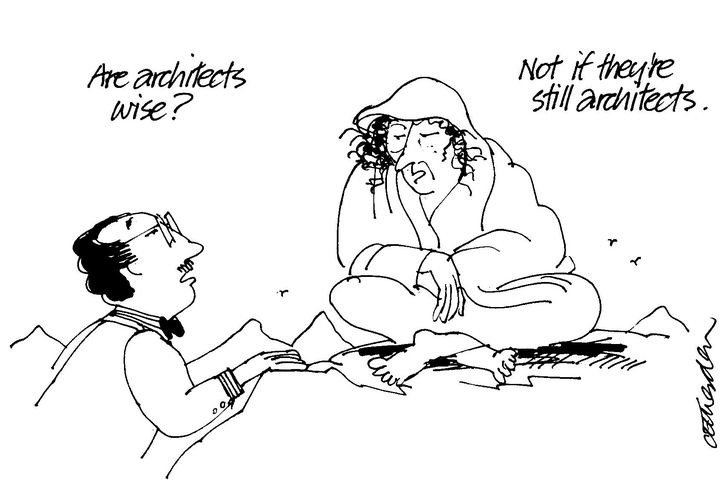Is architecture really “Australia’s second-most overrated degree”? At first glance of the news and television headlines of last week (20-25 January 2014) it seems like yet more alarming news for a profession already facing difficult times. But looking more closely is the key.
The reportage, and the “research” on which it is based is alarmist, but not alarming. Does it matter? The Association of Consulting Architects (ACA) thinks so. As a profession, architecture does face some big issues, and remuneration is one of them (as is the issue of fees). But this kind of sensationalist “research” and reportage makes little useful contribution. Indeed it undermines important and necessary discussions, and gives the public further false impressions of the profession. It is particularly worrying when such reports are directly addressed to students and would-be-students.
The news stories are based on a report by McCrindle Research, which defines ‘underrated’ and ‘overrated’ in relation to starting salaries and the number of graduates who have found employment. So, architecture is deemed overrated on the basis that the median starting salary for Bachelor graduates is identified as $32,500, that only 42 percent of these graduates are available for full-time work, and that of those in a full-time role only 72 percent are working in architecture.
None of this sounds good, but it is worth looking a little closer at where these figures come from, and what they refer to. The report is vague about where its data comes from and its method of analysis. It notes that 512 people across Australia were surveyed (you have to wonder how many architects or architectural graduates were included) and that they drew extra data from various other organisations – Graduate Careers Australia, ABS Measures of Australia’s Progress, DEEWR Higher Education Reports, DIISRTE, and Open Universities Australia.
Architect Gintas Reisgys was one of many who thought the findings sounded odd. After a couple of minutes on Google he tweeted that the architecture salary figures and employment rates cited looked like they were from Graduate Careers Australia (GCA), an organisation that surveys new graduates every year.
The first thing to note is that the median salary figure cited for architecture – $32,500 – is for graduates of Bachelor degrees aged under 25. This is significant because the standard professional degree is now a coursework Masters. (Effectively, the old five-year BArch degree has been split into two – a three-year undergraduate degree followed by a two-year Masters.) For the McCrindle report this is another factor that contributes to architecture’s “overrated” status – it observes that the four “most overrated” degrees all require further study in order to be able work in the discipline. But is also explains why only 42.2 percent of the 590 graduates surveyed were available for full-time work – another 44.6 percent were in full-time study – and why the median salary is so low.
The Architects Award outlines minimum wages for students of architecture, graduates of architecture and newly registered architects. Bachelor graduates who continue in full-time study are still considered “students of architecture” under the award. The median figure of $32,500 cited in the report corresponds to the award wage for students, which is $32,347 for students over 21 years old with less than three years experience. This then increases with every year of experience. Bachelor graduates who are in the period between obtaining a Bachelors degree and commencing the professional Masters – that is, not studying architecture and working in an architectural practice – are covered by the Modern Manufacturing Award (Entry Level C5). (The hourly rate associated for this is $22.31, which is very similar to the graduate of architecture rate of $22.34 per hour, which would result in a higher annual wage than the median salary cited in the study.)

Geoffrey Atherden illustration from Tom Heath’s, What, if Anything, is an Architect? (Architecture Media Australia, 1991).
If we turn to the GCA survey’s finding on graduates from coursework Masters degrees, we find that the median salary is $46,000, that 87.3 percent were available for full-time work and that of those available 76.7 percent were in full-time employment. (It is worth noting, however, that these figures, as with those for Bachelor graduates, come from the 2012 Graduate Careers survey.) Once again this corresponds to the award salary – this ranges from $44,141 for an entry-level graduate of architecture to $51,032 for an experienced graduate.
It is not clear what information about architecture, if any, came from McCrindle’s own survey of 512 people, or if any of these were architecture graduates, but it is worth noting that almost half those surveyed came from NSW, so it is not really nationally representative, and only 21 percent (109 respondents) were in the age bracket 19–33 years, which might be assumed to contain the typical graduate.
The GCA figures raise some important issues, which are certainly worth further consideration. Architecture salaries are low compared to most other graduates, there is a 6.25 percent gap between men and women ($48,000 for men, $45,000 for women), and not all graduates are finding work. But the sensationalist approach doesn’t get us any further in addressing these issues.
Further analysis was done on the GCA figures last year in relation to the question of the gender pay gap. This separated out the data for those following a “traditional” career path. That is, those who:
- Had completed an award in architecture at the Master’s degree level
- Had studied full-time
- Were working as architects in an architectural practice
- Were working between 38 and 42 hours per week.
Within this group, the pay gap was much smaller, but what is most interesting is that this sorting dramatically narrowed the sample size from 566 respondents to 77. That is, most graduates of an architecture coursework masters don’t fit the “traditional cohort” model. It would be very useful to know more about the profile of the other respondents so that we can better understand the educational and early career trajectory of ‘typical’ architectural graduates.
Geoffrey Atherden illustration from Tom Heath’s, What, if Anything, is an Architect? (Architecture Media Australia, 1991).
The last point we would make is that valuing education and careers is a more complicated matter than simply assessing income and employment. The rewards of architecture are not always directly related to monetary derived from it. As Gintas Reisgys also tweeted “In all honesty though, who entered architecture to make money? The pleasure of the job is never conveyed.” That said, the ACA firmly believes that it is imperative that all architectural students, graduates and architects at all levels are fairly recompensed for their work.
The ACA is committed to furthering the serious discussion of business matters in architecture, including remuneration. As a first step in building a better understanding of architectural salaries across the country, the ACA launched the National Salary Survey last year. This will run every six months and will provide a much firmer understanding of architectural salaries across the industry at all levels.
There is no getting around the fact that graduate salaries in architecture are low compared to many other industries and disciplines – and compared to many others in the construction and built environment fields. This is cause for concern. If we want to improve architectural salaries in general we need to improve our business practices, address issues around low fees and fee undercutting, and investigate new business models. This is what the ACA is committed to doing.
What is the ACA?
The Association of Consulting Architects is a member-based organization representing Australian architectural employers. Founded in 1987 as the national peak body representing the interests of employers in industrial matters, it now addresses the “business of architecture” more broadly, with industrial relations as a vital core.
The ACA helps architectural firms navigate the changing world of practice by providing regular advice and information on business and employment matters, by promoting awareness of and discussion about business issues and by advocating for better business practices and legislative frameworks. Through this support and advocacy, the ACA aims to help to ensure the long-term health and viability for the profession, and thereby support the important contribution that architecture makes to our cities, environments, communities and cultures.
The ACA has branches in all states. Its members cover the spectrum of practice sizes – from sole practitioners to large practices – and include a range of business types. In February 2014, the ACA will launch a new website to provide readily accessible resources and advice and will provide an important venue for the developing discussion of business and employment matters in architecture.


















